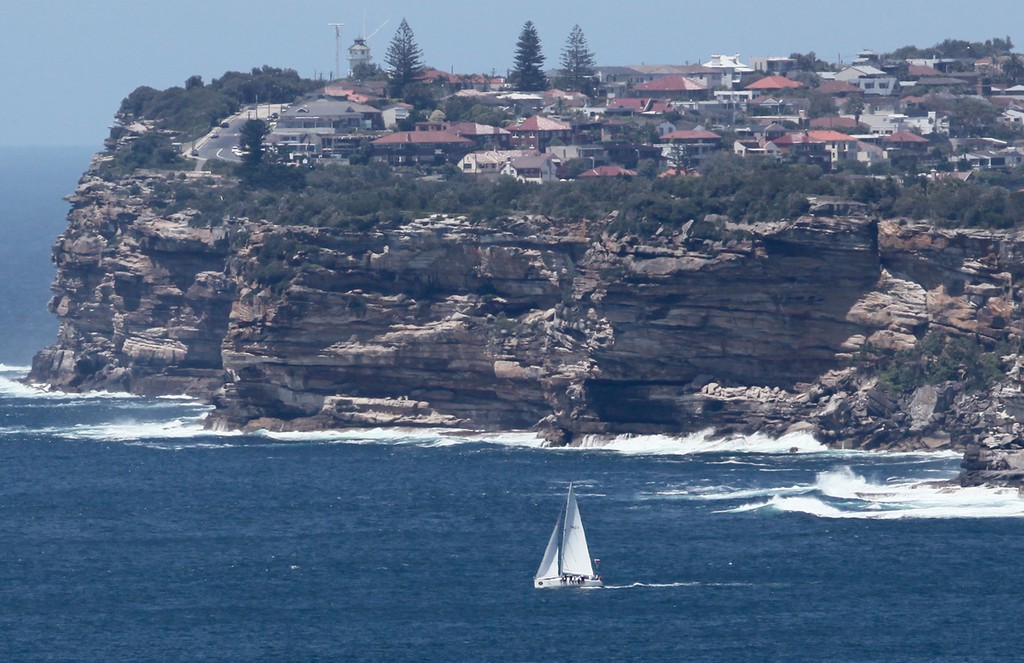Rolex Sydney Hobart; Current little help in the Great Southern Lottery
by Crosbie Lorimer on 25 Dec 2011

Wave Sweeper out practicing on Christmas Day - Rolex Sydney Hobart Yacht Race 2011 Crosbie Lorimer
http://www.crosbielorimer.com
Betting on the Melbourne Cup is at best risky, but you can at least be assured you’ll know the full race conditions before they let the horses loose; by comparison a bet on the Rolex Sydney Hobart Yacht Race outcome is almost akin to buying a lottery ticket.
And never more so than this year, with a race forecast that has even the experts guessing.
Remarkably, a major sports betting agency has one punter opting for a race finish time at one day 19 hours, while the short odds appear to favour 2 days and 2 hours at $1.65 for the line hounours win.
Unsurprisingly, Wild Oats XI has the shortest odds for a line houours win, by a long margin from Investec Loyal, with Lahana and Wild Thing trailing at distance.
But that’s about the only part of this race where any sane person would punt a few bucks and even then the race could easily disappoint.
As to the handicap win, that’s one for the dartboard; pin the fleet list to the bullseye, don a blindfold and throw your arrows; take the result and head down to the betting shop; your odds of a win will be as good as any amount of weather analysis and form checking this year it seems.
A quick discussion with a couple of skippers and crew after the Bureau of Meteorology weather briefing on Christmas Eve morning made it clear that while the first six hours of the race seem relatively assured - a work out of the harbour and set the kite for a solid afternoon of 15-20 knot downwind angles – thereafter, who gets what and where all gets a bit hazy.
Quite when the northeasterlies will die away and the southerly change gradually build is still not clear, but most forecasts today suggest that this is likely to happen somewhere off Ulladalla late afternoon of Boxing Day, so the front end of the fleet may not get quite the lengthy sleigh ride they’d hope for to get clearance from the much-fancied fifty footers.
The northeasterly appears to persist further offshore for a few hours, but with a southwesterly predicted for Bass Strait, going wide is not an option.
Renowned ocean race navigator Stan Honey is aboard Anthony Bell’s 100 foot Investec Loyal for this year’s race and yesterday he too was unclear as to how the second half of the race was going to pan out for them,
'Half way across Bass Strait there’s a lot of uncertainty' said Honey.
While the BoM and CSIRO don’t believe there are enough clear patterns to the Australian East Coast Current in the next few days to suggest a tactical gain by chasing south-going water, Honey believes there is in fact one area where the current will be helpful and that’s around Green Point.
'The reason the models are still a little inconsistent is that with this much cloud cover the thermal models can’t be tested. The altimetry models (measuring sea height, which varies with the speed of the current) suggest a favourable current off Green Point. I think you’ll find the models come into agreement on this over the next couple of days' Honey explains.
But in the pain-for-gain decision making process this one’s not much help anyway,
'With the strong south westerlies forecast for the top of Bass Strait you don’t get much advantage there' says Honey,
'Everyone’s going to want to be close to Green Point anyway at that juncture chimes in Ian ‘Fresh’ Burns, America’s Cup team design co-ordinator for BMW Oracle, possibly sixteen time Hobart racer ('I keep meaning to check that') and Wild Oats XI crew member.
A little over twenty four hours into the race and the wind directions off the East Coast of Tasmania wind clockwise through westerly to northerly, south of St Helens, before gradually swinging to all points of the compass and progressively dying out.
That scenario is going to be a challenge for the front runners who’ll want to be through ahead of that nightmare if they’re not to find the chasing TP52s hot on their heels.
When asked what he thought Wild Oats XI will do if they find themselves off the Tasmanian Coast in limited breeze, Burns confirms the tactics that any dinghy sailor would adopt when faced with the same scenario,
'first we’ve got to stay in pressure' he said 'and with these big boats eight to nine knots is enough to keep you going, but once the breeze is down to 5-6 knots they stop and the smaller ones keep rolling.'
Staying in eight to nine knots may yet prove tricky as Burns confirms 'there’s a bit of question mark over what’s going to happen with that front; it was up at 15-18 knots yesterday and today it’s down to under 10 knots. If that trend continues it will be down to zero in no time' he adds ruefully.
And all this before you even think about whether your arrival time will avoid the infamous Derwent River closedown.
There’s little doubt about it, your money will be a lot safer spent on the post-Christmas sales.
If you want to link to this article then please use this URL: www.sail-world.com/92211